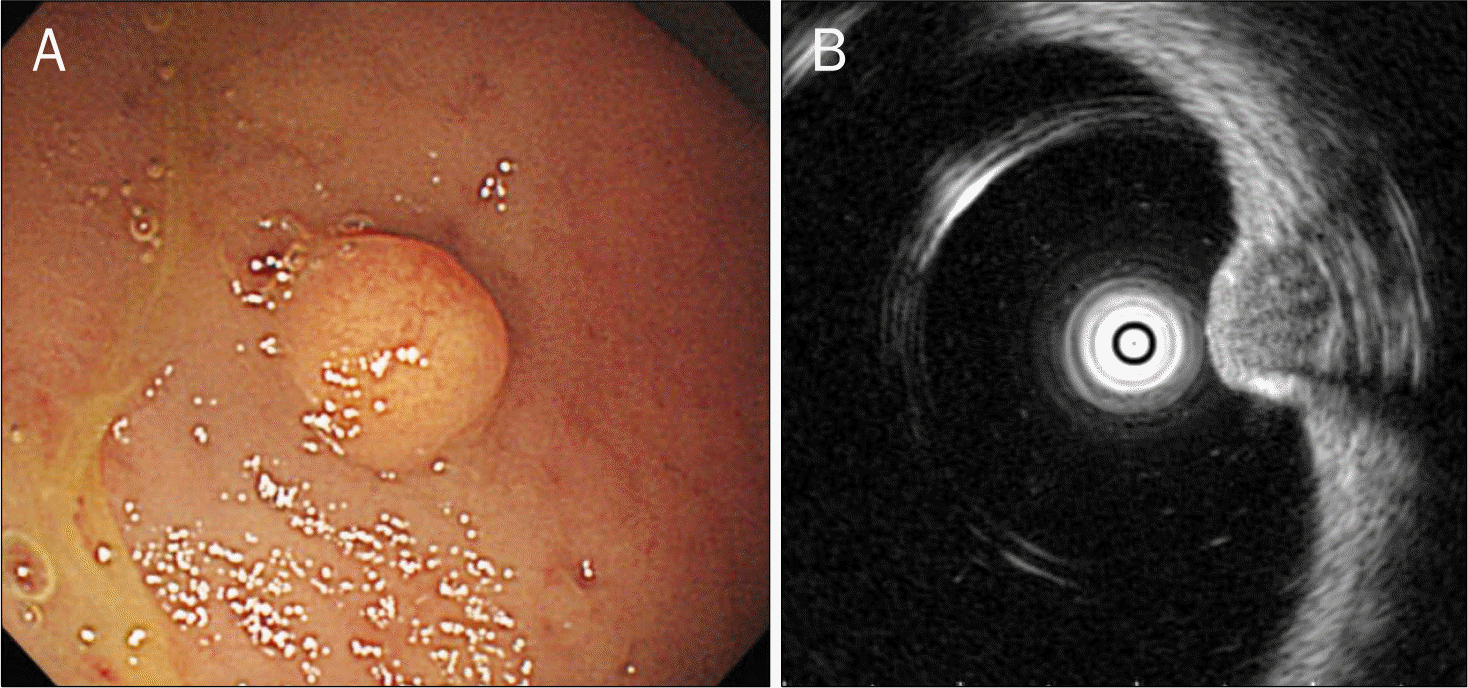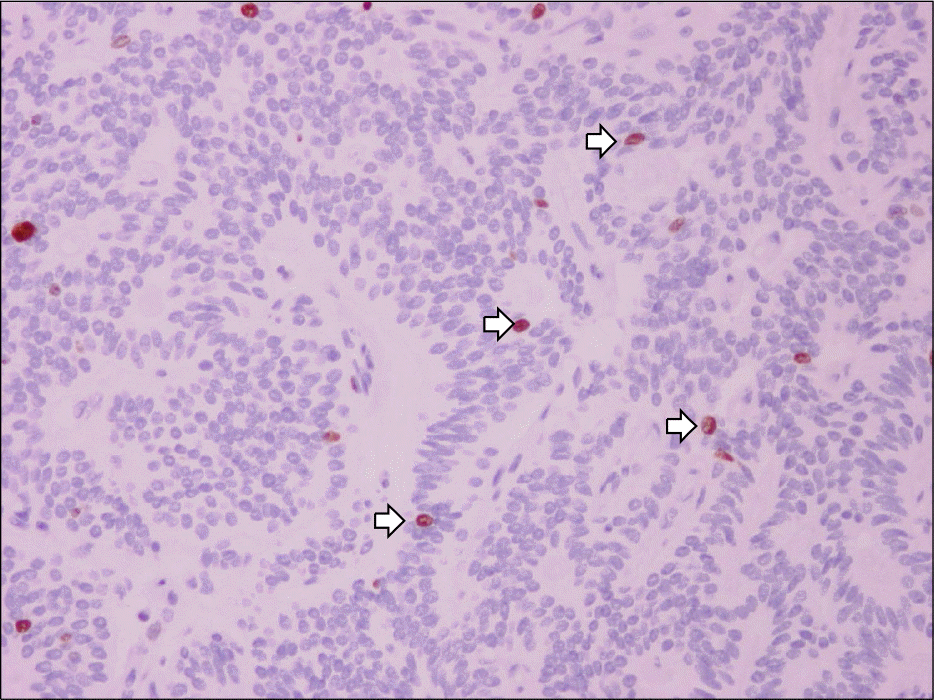Abstract
Background/Aims
Rectal carcinoid tumors can be resected with endoscopy, and it is important to assess their prognostic factors. We evaluated the potential of Ki-67 expression as a prognostic factor in rectal carcinoid tumors.
Methods
We retrospectively reviewed the medical records of 37 patients with rectal carcinoid tumors who got endoscopic resection from January 2001 to January 2011 at Inje University Seoul Paik Hospital. We analyzed their endoscopic and histologic findings, Ki-67 expression, clinical outcome, and prognosis.
Results
The mean age (±SD) of the patients was 56.3±10.7 years, and the male: female ratio was 3.6:1. The mean tumor size was 0.5±0.4 cm, 33 patients showed grade 1 tumors (89.2%) and the average Ki-67 expression was 0.7±1.2%. Thirty five patients underwent endoscopic mucosal resection, and two required endoscopic submucosal dissection. Eight patients had positive margins after resection, but no cases of lymphovascular invasion were identified. The median follow-up duration was 21.4±25.4 months, and no recurrences were observed.
Go to : 
References
1. Jensen RT. Endocrine tumors of the gastrointestinal tract and pancreas. Longo D, Fauci A, Kasper D, Hauser S, Jameson J, Loscalzo J, editors. Harrison's principles of internal medicine. Volume 2. 18th ed.New York: McGraw Hill;2011. p. 3056–3065.
3. Modlin IM, Kidd M, Latich I, Zikusoka MN, Shapiro MD. Current status of gastrointestinal carcinoids. Gastroenterology. 2005; 128:1717–1751.

4. Sun JM, Jung HC. Gastrointestinal carcinoid tumor. Korean J Gastroenterol. 2004; 44:59–65.
5. Soga J. Early-stage carcinoids of the gastrointestinal tract: an analysis of 1914 reported cases. Cancer. 2005; 103:1587–1595.
6. Mashimo Y, Matsuda T, Uraoka T, et al. Endoscopic submucosal resection with a ligation device is an effective and safe treatment for carcinoid tumors in the lower rectum. J Gastroenterol Hepatol. 2008; 23:218–221.

7. Kinoshita T, Kanehira E, Omura K, Tomori T, Yamada H. Transanal endoscopic microsurgery in the treatment of rectal carcinoid tumor. Surg Endosc. 2007; 21:970–974.

8. Lin MX, Wen ZF, Feng ZY, He D. Expression and significance of Bmi-1 and Ki67 in colorectal carcinoma tissues. Ai Zheng. 2008; 27:1321–1326.
9. Klimstra DS, Modlin IR, Coppola D, Lloyd RV, Suster S. The pathologic classification of neuroendocrine tumors: a review of nomenclature, grading, and staging systems. Pancreas. 2010; 39:707–712.
10. Bosman F, Carneiro F, Hruban R, Theise N. WHO classification of tumours of the digestive system. Lyon, France: IARC Press;2010.
11. McCormick D, Yu C, Hobbs C, Hall PA. The relevance of antibody concentration to the immunohistological quantification of cell proliferation-associated antigens. Histopathology. 1993; 22:543–547.

13. Kobayashi K, Katsumata T, Yoshizawa S, et al. Indications of endoscopic polypectomy for rectal carcinoid tumors and clinical usefulness of endoscopic ultrasonography. Dis Colon Rectum. 2005; 48:285–291.

14. Okamoto Y, Fujii M, Tateiwa S, et al. Treatment of multiple rectal carcinoids by endoscopic mucosal resection using a device for esophageal variceal ligation. Endoscopy. 2004; 36:469–470.

15. Ahmad NA, Kochman ML, Long WB, Furth EE, Ginsberg GG. Efficacy, safety, and clinical outcomes of endoscopic mucosal resection: a study of 101 cases. Gastrointest Endosc. 2002; 55:390–396.

16. Moon SH, Hwang JH, Sohn DK, et al. Endoscopic submucosal dissection for rectal neuroendocrine (carcinoid) tumors. J Laparoendosc Adv Surg Tech A. 2011; 21:695–699.

17. Park HW, Byeon JS, Park YS, et al. Endoscopic submucosal dissection for treatment of rectal carcinoid tumors. Gastrointest Endosc. 2010; 72:143–149.

18. Glancy DG, Pullyblank AM, Thomas MG. The role of colonoscopic endoanal ultrasound scanning (EUS) in selecting patients suitable for resection by transanal endoscopic microsurgery (TEM). Colorectal Dis. 2005; 7:148–150.

19. Costes V, Marty-Ané C, Picot MC, et al. Typical and atypical bron-chopulmonary carcinoid tumors: a clinicopathologic and KI-67- labeling study. Hum Pathol. 1995; 26:740–745.
20. Moyana TN, Xiang J, Senthilselvan A, Kulaga A. The spectrum of neuroendocrine differentiation among gastrointestinal carcinoids: importance of histologic grading, MIB-1, p53, and bcl-2 immunoreactivity. Arch Pathol Lab Med. 2000; 124:570–576.
21. Sökmensüer C, Gedikoglu G, Uzunalimoglu B. Importance of proliferation markers in gastrointestinal carcinoid tumors: a clinicopathologic study. Hepatogastroenterology. 2001; 48:720–723.
22. Shimizu T, Tanaka S, Haruma K, et al. Growth characteristics of rectal carcinoid tumors. Oncology. 2000; 59:229–237.

Go to : 
 | Fig. 1.(A) Endoscopic findings. Colonoscopy showed a 0.6 cm sized mild yellowish elevated lesion with intact mucosa at anal verge 7.0 cm site. (B) EUS findings. EUS showed a 0.7×0.6 cm sized hypoechoic lesion in the submucosal layer of the rectum. |
 | Fig. 2.Ki-67 staining in tumors resected by endoscopic mucosal resection (×200). On light microscopic examination, moderately uniform, small, round tumor cells with minimal cellular atypia were seen. The arrows indicate Ki-67 labeled nuclei, and the Ki-67 labeling index was 4% in this sample. |
Table 1.
Grading of Gastroenteropancreatic NET according to Proliferative Activity by WHO Classification
| Grade | Criteria |
|---|---|
| G1 (low grade) | <2 mitoses/10 HPF and <3% Ki-67 index |
| G2 (intermediate grade) | 2–20 mitoses/10 HPF or 3–20% Ki-67 index |
| G3 (high grade) | >20 mitoses/10 HPF or >20% Ki-67 index |
Table 2.
Baseline Characteristics of Patients and Tumors
Table 3.
Comparative Results of Ki-67 Expression with Size, Age, Gender and Involvement of Resection Margin
Table 4.
Correlation of WHO Classification Grade with Size, Age, Gender and Involvement of Resection Margin
Table 5.
Correlation of Ki-67 Expression with Size, Age, Gender and Involvement of Resection Margin




 PDF
PDF ePub
ePub Citation
Citation Print
Print


 XML Download
XML Download